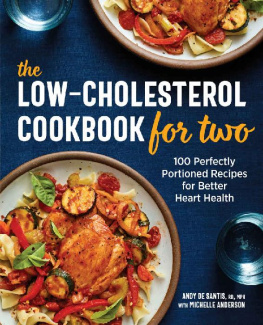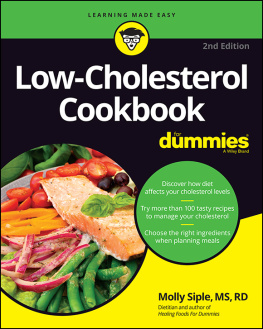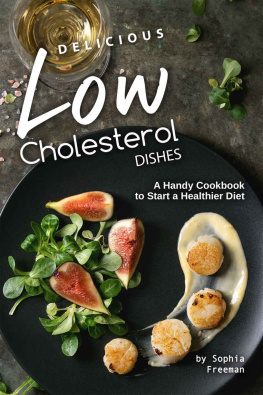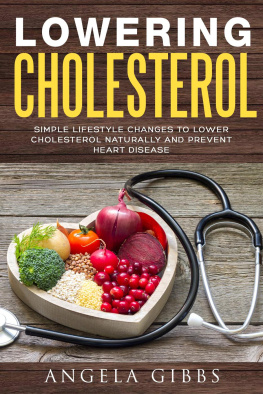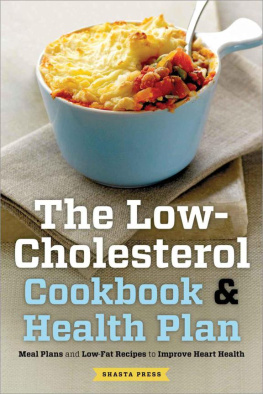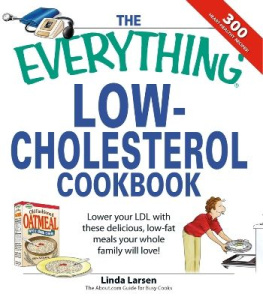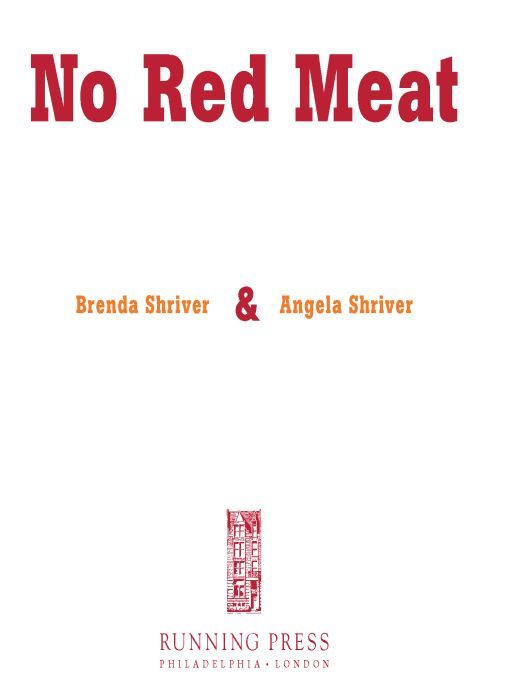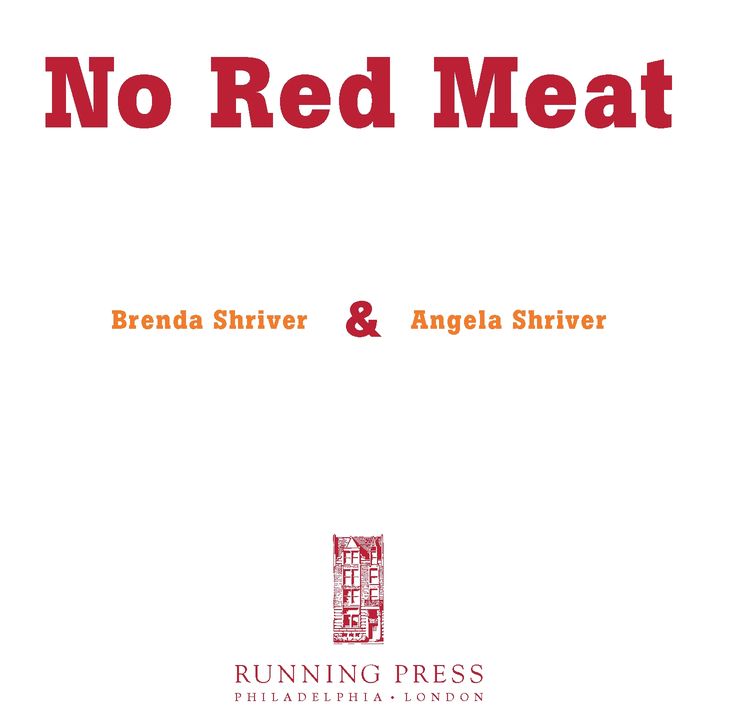Table of Contents
To Our Family
My Greatest Blessing
Acknowledgements
To Angela Shriver, my daughter-in-law and my coauthor, a special thank you for providing all the nutritional information in this book and for your support and faith.
I wish to thank the people who have shared their recipes with me. In addition, thanks to Sally Schaper, who furnished helpful editorial comment and suggestion, and my friends who supported me with their love and prayers.
I am grateful to my family for their moral support, suggestions, and patience over the years as I was developing these recipes. A special thanks to my son, John, III, for overwhelming patience in helping me with the complexities of our computer. I am also thankful to my daughter, Audrey, for her encouragement and suggestions in developing new recipes. And finally, I am most grateful to my husband, John, my most vocal critic and strongest supporter.
Brenda Shriver
This Book is for you!
I originally wrote this cookbook for people with coronary heart disease (CHD) and their family members who are at high risk of developing this disease. However, through the years I have found another segment of the population, the people who simply want to eat healthily, who love this cookbook.
Twenty-six years ago we learned my husband, John, had CHD. At that time his cardiologist told him to change his eating habits to a low-fat, low-cholesterol, no-red-meat diet and continue his vigorous exercise program.
I acquired what few heart cookbooks that were available and started a new way of cooking for our family. After many disappointments, our family agreed most of the recipes were not very tasty and they were either too strict or not strict enough. Plus, we missed some of our family favorites. I began to experiment by preparing new dishes for the family; if the dish got a thumb down, I would make some changes until we agreed the food was tasty and a keeper. Many of the recipes I created by adapting and converting old and new recipes, other recipes are my own creation.
Eventually people started asking for my recipes. I was always happy to share recipes, but there was one major problemall the new recipes were in my head! So it was back to the kitchen. This time I was armed with pen and paper, measuring, cooking, and writing as I worked. I had more recipes than I realized, so at the urging of family and friends, I wrote this cookbook. Now after twenty years I have revised the book to include new ingredients and also many new recipes, which I think you will be pleased with.
Over the years Ive noticed friends and family members with CHD who have failed to adhere to their medically restricted diet. At first I couldnt understand why they failed, but after our familys experience I began to see the difficulty of following this style of eating. Some of the friends would try heart-healthy cookbooks; sometimes it was good some times not so good. There are many kinds of heart cookbooksthe cookbook for a more sophisticated palate and on the other hand there are cookbooks so very strict I cant imagine anyone continuing to eat that way for a lifetime. My No Red Meat cookbook and the way of eating I encourage is not a diet but a lifetime way of eating. I talked to many people about heart diets. In the beginning they were enthusiastic about trying new recipes, especially the more sophisticated or trendy ones. Eventually, after a few weeks of eating food with unfamiliar ingredients the novelty soon wore off and they were back to their old way of eating. People who chose the stricter recipes soon became bored with food that had little taste, didnt satisfy, or was very expensive.They too gradually returned to their old eating habits.
The recipes in this cookbook will satisfy most people who are interested in eating healthier foods. The recipes also include many familiar dishes like Mom used to make.
In
No Red Meat, Ive included:
Vital nutritional information with each recipe.
List of herbs and spices, with suggested uses.
Menu suggestions.
Helpful hints preceding each section.
A wide variety of recipes:
Normal food for everyday.
Special food for entertaining or special occasions.
Traditional food for holidays.
In this collection, I have created healthy, low-fat, low-cholesterol recipes every family member can enjoy. Some are simple enough for the beginning cook. Others are a little more complicated for the more experienced cook who likes to spend time in meal preparation. Many are my familys old favorites that I have converted without sacrificing the good taste.
These recipes were created specifically for my husbands diet.While his sodium intake is not restricted, I use very little salt in my cooking. When using certain canned foods I rely on the sodium included but in other recipes I will call for a small amount of salt. If you are on a salt-restricted diet, make the substitutions Ive suggested using your own ideas or salt-free products to avoid consuming too much sodium. Remember, herbs and spices can add tremendously to a dish.
My husband does not have a weight problem, so he is permitted some sugar. Our family is fond of desserts, so there is an extensive selection of desserts included here. As I plan our daily meals I take into consideration what we have had earlier in the day or will consume later. If the entre contains more fat than usual, I am careful with the remainder of the meal. I make sure other dishes are lower that usual in fat or cholesterol.The same is true for desserts. If the dessert has more fat than usual, I plan a fish or vegetarian entre, keeping in mind the total fat intake for the day.
Meal planning is not hard it just requires a little extra time and effort to maintain a healthy, satisfying diet, but it is possible. Once you become familiar with shopping for the healthier products and using these recipes, it will become second nature.
There are a few products in these recipes I would like to explain.
Margarine: When a recipe calls for butter or margarine it is up to you which you prefer to use. Since they both have the same amount of fat, the difference being that butter is all natural but has saturated fat while stick margarine has hydrogenated shortening. In some recipes you can substitute either canola oil or olive oil. For example when a recipe calls for a bread crumb topping with melted margarine drizzled over all. I spray the breadcrumbs with a vegetable spray and omit the melted margarine.
However, I have found in baking I prefer either stick margarine or butter unless the recipe specifically calls for vegetable oil. I especially like to use butter when a dessert recipe calls for a crumb topping. Margarine is fine to use but I personally think butter gives it a richer taste. Also, in some of the recipes where you pour melted butter over the top, I use butter again because I think it enhances the flavor of the dish. In all my recipes I have slightly reduced the amount of fat and in any recipe I use all types of fat sparingly.You can use this little hint in many ways when cooking.
Liquid shortening/fat: I prefer canola oil and extra-virgin olive oil.
Sweeteners: When using sweeteners, I prefer Stevia simply because it is a natural sweetener and has not been chemically changed. However, some of the packaged artificial sweeteners are better to cook with.


